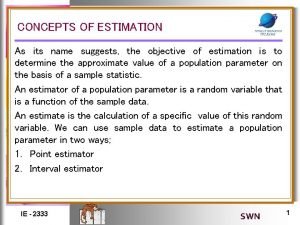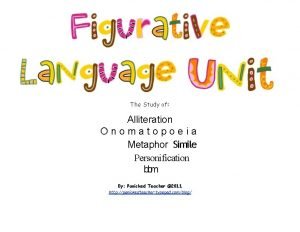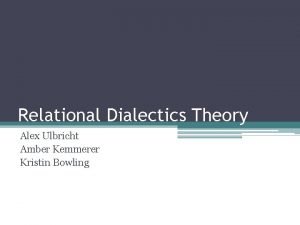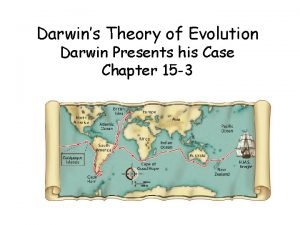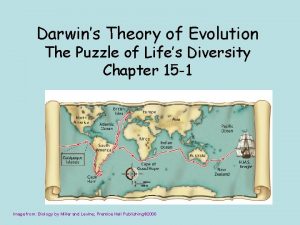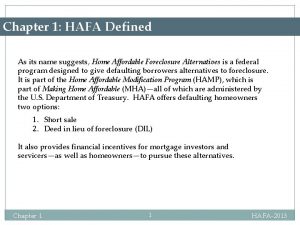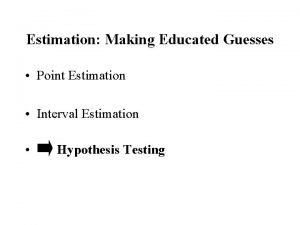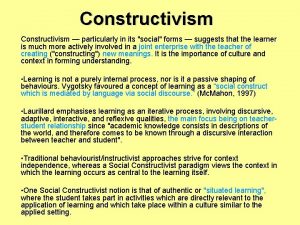CONCEPTS OF ESTIMATION As its name suggests the

















- Slides: 17

CONCEPTS OF ESTIMATION As its name suggests, the objective of estimation is to determine the approximate value of a population parameter on the basis of a sample statistic. An estimator of a population parameter is a random variable that is a function of the sample data. An estimate is the calculation of a specific value of this random variable. We can use sample data to estimate a population parameter in two ways; 1. Point estimator 2. Interval estimator IE - 2333 SWN 1

Definition 1 A population by estimating the value of an un known parameter using a single value or point. estimator Definition interval 2 An population by estimating the value of an unknown parameter using an interval that is likely to include the value of the population parameter IE - 2333 SWN 2

ESTIMATING THE POPULATION MEAN, WHEN THE POPULATION VARIANCE IS KNOWN Suppose that a population has unknown mean and known variance 2. A random sample of size n is taken from this population, say : X 1, X 2, . . . Xn. The sample mean is reasonable point estimator for the unknown mean . A 100(1 - ) percent confidence interval on can be obtained by considering the sampling distribution of the sample mean Therefore, the distribution of the statistic : is a standard normal distribution IE - 2333 SWN 3

so that This equation says that, with repeated sampling from this population, the proportions of value of for which falls between This interval is called the confidence interval estimator of IE - 2333 SWN 4

Definition : If is the sample mean of random sample of size n from a population with known variance 2, a (1 - )100% confidence interval on is given by where Is the upper percentage point of the standard normal distribution. Note : The probability (1 - ) is called the confidence level is called the lower confidence limit (LCL) is called the upper confidence limit (UCL) IE - 2333 SWN 5

SELECTING THE SAMPLE SIZE TO ESTIMATE A POPULATION MEAN One of the most common questions asked of statistician is, how large should the sample taken is a survey be? The answer to this question depends on three factors: 1. the parameter to be estimated 2. the desired confidence level of the interval estimator 3. the maximum error of estimation, where error of estimation is the absolute difference between the point estimator and the parameter; for example, the point estimator of is , so in that case: error of estimation The maximum error of estimation is also called the error bound and is denoted B. IE - 2333 SWN 6

Suppose the parameter of interest in an experiment is the population mean . The confidence interval estimator (assuming a normal population, with the population variance known ) is : If we want to estimate to within a certain specified bound B, we will want the confidence interval estimator to be : As a consequence, we have : solving for n, we get the following result ; sample size necessary to estimate to within a bound B IE - 2333 SWN 7

CONFIDENCE INTERVAL ON A PROPORTION It is often necessary to construct a confidence interval on a proportion. Suppose that a random sample of size n has been taken from a large (possibly infinite) population and that X ( n) observations in this sample belong to a class of interest. Then is a point estimator of the proportion of the population p that belong to this class. If, X ~ BIN (n, p), we known that the sampling distribution of is approximately normal with mean p and variance Thus, IE - 2333 SWN 8

To construct the confidence interval on p, note that : so that : IE - 2333 SWN 9

Definition : Confidence Interval on a Proportion If is the proportion of observations in a random sample of size n that belong to class of interest, then an approximate 100 (1 - ) percent confidence interval on the proportion p of the population that belongs to this class, is : where is the upper percentage point of the standard normal distribution. IE - 2333 SWN 10

CHOICE OF SAMPLE SIZE Since is the point estimator of p, we can define the error in estimating p by If we set size is and solve for n, the appropriate sample (*) The sample size from equation (*) will always be a maximum for p = 0, 5 that is, p(1 -p) 0, 25. In other words, we are at least 100 (1 - ) percent confident that the error in estimating p by is less than B if the sample size is IE - 2333 SWN 11

CONFIDENCE INTERVAL ON THE MEAN OF A NORMAL DISTRIBUTION, VARIANCE UNKNOWN When sample size are small (n 30), we must use another procedure. The usually assumption is that the population is normally distributed. This leads to confidence intervals based on the t distribution. Let X 1, X 2, . . . , Xn be a random sample from a normal distribution with unknown mean and unknown variance 2. The sampling distribution of the statistic is the t distribution with (n-1) degrees of freedom. IE - 2333 SWN 12

Definition : Confidence Interval on the mean of a Normal Distribution, Variance unknown If and s are the mean and standard deviation of a random sample from a normal distribution with unknown variance 2, then a 100 (1 - ) percent confidence interval on is given by where is the upper percentage point of the t distribution with (n-1) degrees of freedom. IE - 2333 SWN 13

CONFIDENCE INTERVAL ON THE VARIANCE OF A NORMAL DISTRIBUTION Suppose that we wish to find a confidence interval estimate for the variance 2 of a normal population. If X 1, X 2, …Xn is a random sample of size n from this normal population and if S 2 is the sample variance, then S 2 is a reasonable point estimator of 2. Futhermore, S 2 is used in finding the confidence interval for 2. If the population is normal, the sampling distribution of : is chi-square with (n-1) degrees of freedom. IE - 2333 SWN 14

To develop the confidence interval : so that : This last equation can be rearranged as : IE - 2333 SWN 15

Definition : Confidence Interval on the Variance of a Normal distribution. If s 2 is the sample variance from a random sample of n observations from a normal distribution with unknown variance 2, then a 100 (1 - ) percent confidence interval on 2 is : and are the upper and the where lower percentage points of the chi-square distribution with (n -1) degrees of freedom respectively. IE - 2333 SWN 16

ONE SIDED CONFIDENCE INTERVALS To find a 100 (1 - ) percent lower-confidence interval on 2, giving by : The 100 (1 - ) percent upper-confidence interval is : IE - 2333 SWN 17
 As its name suggests
As its name suggests What is simile
What is simile Name three lines
Name three lines In paragraph 1 impatient of is best interpreted as meaning
In paragraph 1 impatient of is best interpreted as meaning Neo freudian theory
Neo freudian theory Size diminution suggests depth by
Size diminution suggests depth by The efficient market hypothesis suggests that _______.
The efficient market hypothesis suggests that _______. Dialectic theory suggests that relationships
Dialectic theory suggests that relationships Features of projective personality test
Features of projective personality test Whales have vestigial legs. this suggests they _____.
Whales have vestigial legs. this suggests they _____. An elementary school classroom in a slum rhyme scheme
An elementary school classroom in a slum rhyme scheme Whales have vestigial legs. this suggests they _____.
Whales have vestigial legs. this suggests they _____. Red indicates devotion, courage, bravery
Red indicates devotion, courage, bravery The emigree poem
The emigree poem When a train increases its velocity, its momentum
When a train increases its velocity, its momentum Sunny rainy snowy windy cloudy
Sunny rainy snowy windy cloudy If its a square it's a sonnet summary
If its a square it's a sonnet summary Its halloween its halloween the moon is full and bright
Its halloween its halloween the moon is full and bright
